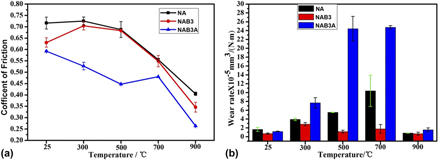Crossref Citations
This article has been cited by the following publications. This list is generated based on data provided by
Crossref.
Zhu, Shengyu
Cheng, Jun
Qiao, Zhuhui
and
Yang, Jun
2019.
High temperature solid-lubricating materials: A review.
Tribology International,
Vol. 133,
Issue. ,
p.
206.
Zarezadeh Mehrizi, M.
Momeni, M.R.
Beygi, R.
Eisaabadi B., G.
Kim, Bong-Hwan
and
Kim, Shae-Kwan
2019.
Reaction pathway of NiAl/WC nanocomposite synthesized from mechanical activated Ni Al W C powder system.
Ceramics International,
Vol. 45,
Issue. 9,
p.
11833.
Talaş, Şükrü
and
Oruç, Göksel
2020.
Characterization of TiC and TiB2 reinforced Nickel Aluminide (NiAl) based metal matrix composites cast by in situ vacuum suction arc melting.
Vacuum,
Vol. 172,
Issue. ,
p.
109066.
Feng, Xiaochun
Lu, Cheng
Jia, Junhong
Xue, Jiali
Wang, Qihua
Sun, Yuan
Wang, Wenzhen
and
Yi, Gewen
2020.
High temperature tribological behaviors and wear mechanisms of NiAl–NbC–Ag composites formed by in-situ decomposition of AgNbO3.
Tribology International,
Vol. 141,
Issue. ,
p.
105898.
Feng, Xiaochun
Jia, Junhong
Gao, Qiang
Lu, Cheng
Yang, Jingjing
Shi, Peiying
Wang, Wenzhen
Yi, Gewen
and
Wang, Qihua
2021.
Regeneration mechanisms of silver niobate in NiAl composites with respective addition of AgNbO3 and Ag/Nb2O5 at elevated temperatures sliding.
Tribology International,
Vol. 153,
Issue. ,
p.
106623.
Guo, Hongjian
Li, Bo
Yan, Pengxun
Wu, Zhiguo
Li, Fuli
and
Liu, Zhiyuan
2022.
Microstructures, mechanical properties and tribological behaviors of NiAl-based composite coatings with various addition of Nb.
Surface and Coatings Technology,
Vol. 449,
Issue. ,
p.
128977.
Gao, Qiang
Wang, Wenzhen
Yi, Gewen
Wan, Shanhong
Shan, Yu
Feng, Xiaochun
Sun, Huwei
Shi, Peiying
and
Cheng, Qianqian
2022.
Study on the oxidation behaviours and the interactions between friction and oxidation of the Ni-based composites with in-situ carbides reinforcement at 800 ℃.
Corrosion Science,
Vol. 195,
Issue. ,
p.
109987.
Liu, Jiongjie
Dong, Changyu
Lu, Xuefeng
Qiao, Zhuhui
Zhou, Feng
Liu, Weimin
and
Riedel, Ralf
2022.
Sn-containing Si3N4-based composites for adaptive excellent friction and wear in a wide temperature range.
Journal of the European Ceramic Society,
Vol. 42,
Issue. 3,
p.
913.
Piechowiak, Daria
Kania, Albert
Łukaszkiewicz, Natalia
and
Miklaszewski, Andrzej
2023.
Properties and Microstructure Evaluation in NiAl-xWC (x = 0 − 90 wt.%) Intermetallic-Based Composites Prepared by Mechanical Alloying.
Materials,
Vol. 16,
Issue. 5,
p.
2048.
Guo, Hongjian
Yan, Pengxun
Wu, Zhiguo
Li, Bo
Li, Fuli
Hu, Jun
and
Chen, Zhong
2023.
Lubrication mechanisms of Nb-contained oxides characterizing tribochemistry of NiAl/Nb/Ag composites coatings revealed by the density functional theory (DFT) computation.
Tribology International,
Vol. 182,
Issue. ,
p.
108352.
Roy, Amit
Patel, Payank
Sharifi, Navid
Chromik, Richard R.
Stoyanov, Pantcho
and
Moreau, Christian
2023.
Binary and ternary lubricious oxides for high temperature tribological applications: A review.
Results in Surfaces and Interfaces,
Vol. 11,
Issue. ,
p.
100117.
Sun, Biao
Ding, Feng
Qiu, Bo
Zhao, Yingxiang
and
Guo, Junde
2023.
High temperature tribological properties of NiAl-Ag2Mo2O7 composite coatings prepared by spark plasma sintering.
Surface and Coatings Technology,
Vol. 456,
Issue. ,
p.
129290.
Singh, Bipin Kumar
2023.
State-of-Art on Self-Lubricating Ceramics and Application of Cu/CuO as Solid Lubricant Material.
Transactions of the Indian Ceramic Society,
Vol. 82,
Issue. 1,
p.
1.
